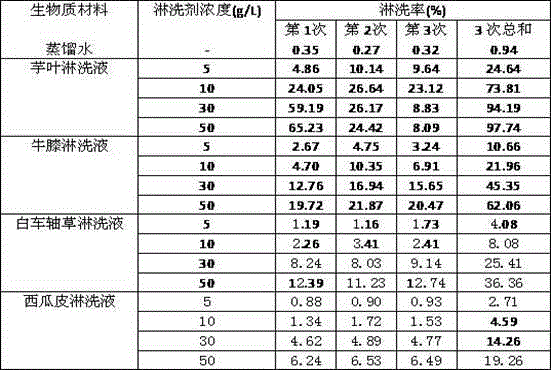Method for removing lead from contaminated soil by virtue of taro leaf or achyranthes bidentata leaching
A technology of polluted soil and taro leaves, applied in the field of remediation of polluted soil in the environment, can solve the problems of low efficiency, high cost, secondary pollution, etc., and achieve the effect of convenient operation and obvious effect
- Summary
- Abstract
- Description
- Claims
- Application Information
AI Technical Summary
Problems solved by technology
Method used
Image
Examples
Embodiment 1
[0024] 1. Preparation of contaminated soil eluent
[0025] Wash taro leaves, achyranthes bidentata, white clover and watermelon peel with tap water respectively, rinse with distilled water, place them in a naturally ventilated place to air dry, and use a grinder to grind them through a 2mm sieve.
[0026] Add 10g, 20g, 60g and 100g of taro leaf powder to 2000ml of distilled water, vibrate and extract at a speed of 180r / min for 12h and then filter, so that the taro leaf powder and distilled water are fully contacted and mixed. The eluents with concentrations of 5g / L, 10g / L, 30g / L and 50g / L of taro leaves were prepared respectively. The preparation method of distilled water extraction eluate with the concentration of 5g / L, 10g / L, 30g / L and 50g / L of Achyranthes bidentata, white clover and watermelon rind is the same as that of taro leaf eluate.
[0027] , leaching of contaminated soil
[0028] According to distilled water, distilled water + 5g / L taro leaf eluent, distilled wate...
Embodiment 2
[0035] 1. Preparation of taro leaf and Achyranthes knuckle lotion
[0036] Wash the taro leaves and Achyranthes bidentata respectively with tap water, place them in a naturally ventilated place to air-dry, and use a grinder to grind them.
[0037] Add 0.5kg, 1kg, 3kg and 5kg of taro leaf powder to 100L tap water, oscillate and extract at a speed of 180r / min for 12h, and then filter with gauze to obtain solutions with taro leaf concentrations of 5g / L, 10g / L, 30g / L and 50g / L eluent. Achyranthes bidentata concentrations of 5g / L, 10g / L, 30g / L and 50g / L tap water eluents were prepared in the same way as taro leaf eluents.
[0038] , leaching of 500g contaminated soil
[0039]According to tap water, tap water + 5g / L taro leaf rinse, tap water + 10g / L taro leaf rinse, tap water + 30g / L taro leaf rinse, tap water + 50g / L taro leaf rinse; tap water + 5g / L Achyranthes bidentata eluate, tap water+10g / L Achyranthes bidentata eluate, tap water+30g / L Achyranthes bidentata eluate, tap wat...
Embodiment 3
[0048] The preparation method of the leaching agent and the rinsing steps of the polluted soil are kept consistent with the conditions in the examples, only the volume ratio parameters of the polluted soil and the eluent of the biomass material are changed, and the test is performed under different ratio conditions. Changes, see Table 3 for specific data.
[0049] Table 3 Efficiency of four biomass materials to remove lead from polluted soil under different soil-liquid ratio conditions
[0050]
[0051] Note: The concentration of the eluting agent is the extraction concentration of taro leaf, hyssop, white clover and watermelon rind; each treatment was repeated 3 times, and the data in the table are the average value of 3 repetitions.
[0052] It can be seen from Table 3 that under the same conditions, the leaching agents prepared by using biomass materials taro leaves, hyssopia, white clover and watermelon rinds respectively, under the same concentration conditions of lea...
PUM
 Login to View More
Login to View More Abstract
Description
Claims
Application Information
 Login to View More
Login to View More - Generate Ideas
- Intellectual Property
- Life Sciences
- Materials
- Tech Scout
- Unparalleled Data Quality
- Higher Quality Content
- 60% Fewer Hallucinations
Browse by: Latest US Patents, China's latest patents, Technical Efficacy Thesaurus, Application Domain, Technology Topic, Popular Technical Reports.
© 2025 PatSnap. All rights reserved.Legal|Privacy policy|Modern Slavery Act Transparency Statement|Sitemap|About US| Contact US: help@patsnap.com



